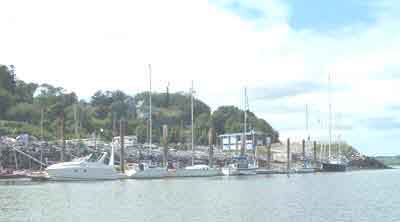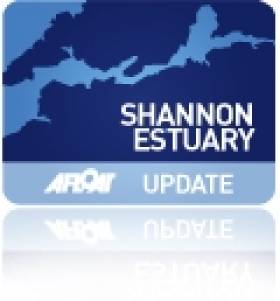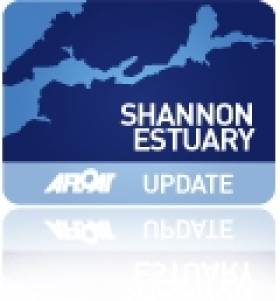Displaying items by tag: Foynes Yacht Club
Galway J109 Crew are Superleague Performers
Glen Cahill and the crew of the J109 Joie de Vie from Galway Bay Sailing Club were crowned overall winners of the West Coast Super League 2010 in both IRC & Echo at the prize giving held last Saturday night at Foynes Yacht Club.
The Murphy Marine Services sponsored league was an extracted series of seven events on the West Coast of Ireland and is organised by the West of Ireland Offshore Racing Association with the help from various clubs involved which where Galway Bay Sailing Club, Tralee Bay Sailing Club, Clifden Boat Club, Foynes Yacht Club and the Royal Western Yacht Club of Ireland.

Simon Mc Gibney (WIORA Commodore) Glen Cahill, Jennifer Cuddy, Chris Law, Bobbi O Regan (WIORA) Bernard McCarthy. More prizegiving photos below
The events where the Tralee Bay Sailing Club Regatta, West Coast Championships hosted by the Royal Western Yacht Club, O'Sullivan Marine 100 Mile Race, Clifden Boat Club Regatta, Galway Bay Sailing Club Regatta, Northwestern Offshore Racing Association Regatta hosted by Galway Bay Sailing Club and Foynes Yacht Club Regatta.
In excess of sixty boats took part in the various events during the League and the final placing where not decided until the Foynes Yacht Club Regatta was completed.
Joie de Vie had a very impressive season wining Class 1 in no less than four of the seven events including the West Coast Championships and fought off stiff competition from Raymond McGibney's Dehler 34 Disaray from Foynes Yacht Club, who finished overall runner up in both IRC & Echo and Liam Burke's Corby 33 AWOL from Galway Bay Sailing Club who collected the most competed events WIORA Trophy and Rob Allen's Corby 36 Mustang Sally from the Royal Western Yacht Club of Ireland.
Results after all seven events completed -
Overall IRC & ECHO
Overall IRC & ECHO Winner – Glen Cahill's J109 Joie de Vie Galway Bay Sailing Club
Overall IRC & ECHO Runner up - Raymond Mc Gibney Dehler 34 Disaray Foynes Yacht Club
Class Prize & The most competed events WIORA Trophy
Liam Burke's Corby 33 AWOL Galway Bay Sailing Club
Class Prize
Rob Allen Corby 36 Mustang Sally Royal Western Yacht Club of Ireland

Awol: Bobbi O Regan (WIORA) Nigel Thornton, Noreen Mc Carthy, Simon Mc Gibney (WIORA Commodore)

Disaray Crew: Simon Mc Gibney (WIORA Commodore) Edward Enright, Fionn Mc Gibney, Louise Barrett, Rory Mc Gibney, Bobbi O Regan (WIORA) Raymond Mc Gibney

Mustang Sally: Simon Mc Gibney (WIORA Commodore), Rob Allen, Bobbi O Regan (WIORA)
Tricky Conditions for Shannon Estuary Cappa Race
On Saturday last with the weather favourable, members of Foynes Yacht Club raced in the annual Cappa fixture, which has been on the sailing calendar for a considerable time.
Unfortunately, the Glin Castle race was cancelled beyond Foynes Yacht Club control, but instead the Cappa race was held on Saturday instead of Sunday.
Two classes raced, Class 1 and 2. Class 1 were racing for the Cappa Cup, while Class 2 competed for the Sean Keating Trophy.
Eleven yachts 'took to the water', where Officer of the Day, Ray McGibney sent both fleets 'off' for an 11am start. A force 4 to 5 north-westerly wind made sailing quite tricky for the fleet. With the tide 'flushing' down the estuary and choppy seas made the race somewhat interesting, where the boats had to tack to reach the Clare coastal village of Cappa.
With a hard fought race and more or less neck and neck, in class 1 winners of the recent Carrigaholt cup, Battle, emerged victorious beating off John and Edward Conway in Golden Kopper, who came in second. Third was Andrew Bracken on Joyrider.
In class 2 the Sean Keating Trophy was won by James McCormack on Alphara; second was Pat Finucane on Marengo and third Jazmin 2.
A crews race back up the estuary to Cooleen Point took place, where a Bar-B-Que was held in the clubhouse afterwards, where the culinary delights of the chef's kept the hungry sailors wanting more.
Next Sunday the September series of racing will commence for all classes, and it is envisaged that all boats will be racing in their respective classes. All crew and skippers are asked to be at the club at 1pm, where a briefing will take place before racing. First gun for all races will be 2.30pm.
Club racing continues every Wednesday evening with first gun at 7pm.
Racing Continues Apace at Mermaid Week
Race 3 of the National Mermaid Championship starts today at 15:00, followed by the annual 'crew' race. Five times champion Derek Joyce in 187 Zuleika has a major challenge to stay in the running and really needs a win to stay in contention. The stiffer breezes foretasted today should suit him. Another boat with some work to do is 131 Wild Wind, sailed by last year's champion Paddy Dillon; as he is lying third overall at seven points, he needs to stay in the top three today.
Yesterday's winner, Shay O'Toole (182 Dolphin) is lying 6th overall and another win today could put him in contention for the Championship. Current overall leader Jim Dempsey (183 Wannago), with two seconds under his belt, needs to maintain consistency as four times champion Jim Carthy (123 Vee) is hot on his heels just one point behind.
Of the 186 Mermaids built since 1932, some have been built by professionals and some by amateurs. Amateur is, perhaps not the best word as many Mermaid sailors are carpenters, furniture makers and woodwork teachers by profession and have build fast boats to exacting standards. The most prolific builders over the years have been John Brennan of Dun Laoghaire (16 boats), James Kearney (15 boats) and Skee Gray (10 boats).
Of the thirty three boats competing this week, Brennan built three, Harry & Tom Grieves built three and Des Tyrell built three. Four sailors are on board boats they built themselves: Frankie Browne (135 Cara II), Martin O'Toole (179 Bean Adhmaid), Shay O'Toole (182 Dolphin) and Ross Galbraith (185 The Message). Former champion Joe Boylan built the boats being sailed by his son Aidan (138 Zeila) and grandson Mark (177 This Is It).
If there was a Formula 1 style 'Constructor's Championship', the top three builders since 1953 would be: Harry & Tom Grieves, 9 wins; John Brennan, 8 wins and Des Tyrell, 7 wins. This year the Grieves boats are 73 Lively Lady, 76 Helen and 77 Tiller Girl. The Brennan boats are 131 Wild Wind, 143 Jill and 146 Fugitive, while the Tyrell boats are 186 MyDi, 187 Zuleika and 188 Innocence. It's all to play for.
Live updates will be blogged from the race area today at http://www.dublinbaymermaid.org/foynes2010/index_files/Commentary.htm.
Foynes Yacht Club

Foynes Yacht Club
Foynes Yacht Club was founded in 1962, it has a modern club house with good facilities, bar, showers, changing rooms, kitchen and dance floor. Floating pontoons and deep water moorings allow ease of access to boats at all stages of the tide. Racing every Wednesday evening during the season. Membership is open to all, and Juniors are especially welcome.
Foynes Yacht Club – Its settings and origins – by R.J. Scott, 1991
In the age of commercial sail right up to the 1914–18 War, the Shannon Estuary was used regularly by coasting schooners and the like. Records show a considerable use of quays at Kilrush, Foynes, Kiladysert by these fine old wooden vessels. In fact, the Clare river (Fergus) was worked right up to Clarecastle in schooners and brigantines carrying as much as 320 tons of coal on 12.5 ft. draft, and that often without power other than flax, wind, a damn good kedge anchor and an even better six-man crew! Within the Estuary, as recently as 1954, the final cargo under sail was carried from Limerick when the late Johnny Davis put his 25-ton cutter Alzina on the mud at Labasheeda for the last time. Today motor craft have taken over from seagoing sail, fewer but bigger, and the lower Shannon sees them in all shapes of increasing ugliness, from 500 to 170,000 tons. In an age where carrying capacity is god and aesthetic beauty of line no longer of value in complex Balance Sheets, estuary craft like the Alzina, Edgar, Lahloo, Baron Joss, Mary Joseph and others have surrendered to the economics of road transport.
The traditions of sail have been passed on and nurtured to a degree by yachtsmen the world over. Yet strangely, the Shannon Estuary appeared to lose much of this contact, that is apart from a comparatively few individuals, hardly more than a dozen or two at one time between 1920 and 1962. Perhaps the best known figure of this era was the late Conor O'Brien of Foynes who, fifty years ago this year (1991), sailed round to Dublin and took his departure on 23rd June in his 20-ton Baltimore-built ketch Saoirse. Exactly two years later to the day, he arrived back to a massive welcome having circumnavigated the world. His craft was the first to carry the new Irish tricolour round the globe. Conor's writings are widely read and his home may still be seen, set amongst the trees on Foynes Island.
It was inevitable, of course, that with the increasing popularity of yachting on other coasts the pastime should develop in the Estuary. In July, 1962 seven boat-owners, five from Limerick, one from Foynes and one from Newcastle West,got together in a Foynes local and simply formed a club. So Foynes Yacht Club was born. For the record, the seven founders were: Dan O'Sullivan (Commodore), Dick Nash (Secretary), Peter Lawless (Treasurer) with Peter McKenna, Pat Dinneen, Joe Bottcher and Roger Bourke.
From this small beginning Foynes Yacht Club had grown to a membership of one hundred and eighty by 1973. That year marked a long sought milestone, the opening of the new clubhouse. With it's 250ft boat slip built by members in 1971, it gave Foynes and the lower Shannon Region it's first major water based leisure facility.
Coincidentally, the West of Ireland Offshore Racing Association's Annual Championship for Cruisers, also established 1973, has been hosted successfully every third year by the club since then.
Dublin Bay Mermaids were very popular in the club during the early seventies, declined almost to extinction in the eighties, but have returned more popular than ever in the nineties. But, if the Mermaids numbers declined, interest by Mermaiders in Foynes didn't and the Mermaid National Championship was hosted by the club in 1973, 1977, 1984 and 1989 and is again scheduled for 1993. Meanwhile the club instituted The Munster Mermaid Championship in 1990 as an annual event which even attracts boats from the east coast to participate.
Perhaps the busiest year for the club was 1989 when it hosted a GP14 Championship in May, the West of lreland Offshore championship in July, the Mermaid Nationals in August and then revived the town Regatta in September. The club continued to improve by developing its facilities, reclaiming and rockfacing the foreshore, extending and paving the dinghy and car parks and widening the slipway. The Club constructed the first Marina on the west coast, a development which is being considerably extended and improved this year. Plans are also in hand to improve the clubhouse.
And today's club...
The river Shannon is the longest river in the British isles. It rises in Co Cavan and enters the Atlantic ocean in the southwest of Ireland. It is tidal west of Limerick city. It's estuary has a tidal range of over 5 metres and it can run at over 4 knots in places.
Foynes is located in the southwest of Ireland on the southern shore of the Shannon estuary on a channel formed by Foynes Island. It has a very busy commercial port and to the west of this Foynes Yacht club. It is about 25 miles west of Limerick city on the N69.
In the club there are about 12 yacht over 9 metres, eight in the 7–9 metre range and about ten active mermaids plus other dinghies. We race every Wednesday evening during the summer months and on Sundays in September as well as some annual weekend events. In all there are just over 130 members.
Our facilities include a modern clubhouse with bar, dance floor, toilets and showers.
We have a pontoon which can accommodate approximately eight visiting boats, four club boats, the club crashboat and 12 dinghies.
All other boats are kept on swinging moorings on the east side of Foynes island. Additionally there is a wintering compound for 30 yachts and a launching slip.
(The above information and image courtesy of Foynes Yacht Club)
Foynes Yacht Club, Cooleen Point, Foynes, Co. Limerick. Tel 353 62 65261
or
c/o Elaine O' Mahoney, Coolen Point, Foynes, Co Limerick. Tel: 069 65261, email: [email protected]
Have we got your club details? Click here to get involved

























































